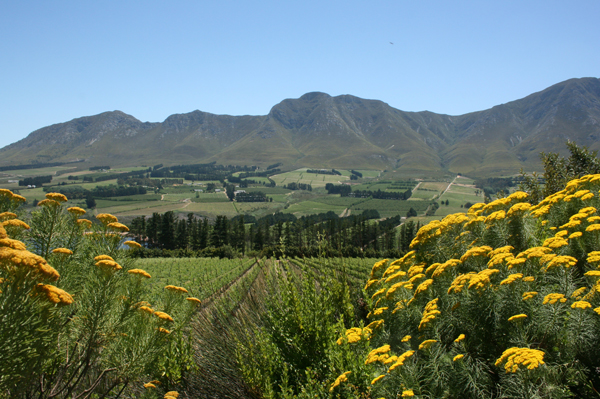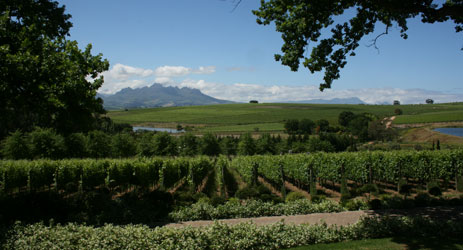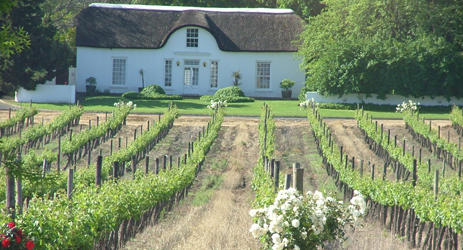Jefford on Monday
Anyone seeking dental refuge from the searching acidity which will have been on display at London’s recent 2013 Burgundy tastings could have done worse than made their way south this weekend. All the way south, as far as you can go: to South Africa’s Hemel-en-Aarde Pinot Noir Celebration, which unfolded over the last two days of January. I pre-tasted the event, as it were, with a day of visits last November.
It reminded me that the one grape variety with which the three Anglophone Southern Hemisphere wine nations jointly excel is -- against all expectations -- Pinot Noir. The latitudes may look unpromising, but by judiciously conjoining altitude, wind and ocean influence, a new sort of global Pinot beauty has come into being: juicy yet elegant, often fine-grained and perfumed, marked by tempered richness. I still miss Burgundy’s purposeful tannins in leading Southern Hemisphere examples, but the draughtsmanship with which their fruit is sketched can be irresistible, and their balances are easier on the non-aligned palate than that of Burgundy after a cold, rainy summer.

You can’t ignore the human factor, either. Those deciding on Cabernet, Merlot or Shiraz want to run a sound business; those planting Pinot usually hope to make the best wine in the world. Their faces are lit by the gleam of the grail, and their actions marked by a purity of spirit which often underwrites great winemaking.
I remember meeting Tim Hamilton Russell, the Hemel-en-Aard valley pioneer, two decades ago when his vineyard was a muddy and lonely one, and when he was engaged in the inevitable battles with the KWV over planting rights and vine material. By the time he died in July 2013, his foresight had been paid the greatest complement of all: the valley was waving with vines. According to his son Anthony, it was ‘the vineyard which chose Pinot Noir and Chardonnay’ as key varieties for the family estate; there were eight planted when Anthony took over. Economic evolution has left these two.
These are not South Africa’s most southerly plantings, but they’re close, and (like those of the Mornington Peninsula in Australia’s Victoria) they’re highly maritime. As always in the Cape, you have to look at the mountain context and calibrate it against wind direction to understand the climate. The physical valley’s opening to the sea is suitably angled for the prevailing south-easterlies to shear directly off the cold Benguela current, and the high Babylonstoren mountains curtain the zone from the warmth inland.
Hamilton Russell planted in the lower part of the valley; most of the expansion subsequently has come further up, in the separate wine wards of Upper Hemel-en-Aarde Valley and the Hemel-en-Aarde Ridge. There’s no limestone but plenty of clay in the subsoils, particularly lower down in the valley, with the parent material being ancient decomposed shale, sandstone and granite. There are problems, too. Gourmet, Pinot-loving baboons are one. Leaf-roll-virus affected vines, as so often in South Africa, is another.

Image: Anthony Hamilton Russell
© Andrew Jefford
Or is it? ‘Michael Brajkovich of Kumeu River in New Zealand,’ says Anthony Hamilton Russell, ‘says a little leaf-roll in his Chardonnay makes his wines much less New Worldly and that people love it. I honestly believe that one of the hallmarks of Hamilton Russell wines comes from a degree of leaf-roll, but you do have to accept 33 per cent crop reduction. It suits some varieties more than others. You have to want the held-back style, the restraint.’ He says he has replanted the entire vineyard one and a half times.
‘There’s no good news on virus for me,’ ripostes Gerhard Smith of La Vierge, up on the Hemel-en-Aarde Ridge. He suggests that the whole of the Ridge is virus-free at present. Leaf-roll will have to be conquered, of course, if there are ever to be any ‘old vine’ bottlings from Hemel-en-Aarde.
Don’t assume that I’m taking a stand on this question (I know too little to do that), but the Hamilton Russell Pinots are exceptionally accomplished wines: the 2013 had impressive architecture of fruit, with plenty of lithe thrust to it; light but palpable tannins; freshness; and a peppery, pungent finish.
Other outstanding Hemel-en-Aarde Pinots include the two 2013 bottlings from Storm Vrede from a Valley site (stocky, rounded and chunky, Pommard-style) and Moya’s from the Upper Valley (sappy, mouth-coating red fruits, Volnay-style). Look out, too, for the 2013 Newton Johnson Family Vineyards (fresh, poised and charming, with gathered folds of sappy plum fruit) from the Upper Valley; and Creation’s 2013 Reserve Pinot (meaty, spicy, dense, almost peaty) from the Ridge.
It’s early days, of course: Kevin Grant, a former winemaker for Hamilton Russell, now has his own estate up on the Ridge called Ataraxia, but the only Pinot he has released so far has gone to market with ‘Declassified’ on the label, and without an origin other than Western Cape. ‘It quickly became obvious that the thing I like most in Pinot Noir, which is texture, you can’t get in very young vines. So I’m waiting for the texture.’
Oh, and one last thing. Anthony Hamilton Russell’s great-great aunt once shot Mussolini on the nose. It’s not strictly relevant, I agree, but since Anthony saw fit to mention it, I thought I’d pass it on: one last little reason to head south.

Columnist Introduction
Andrew Jefford is a columnist for both Decanter magazine and www.decanter.com, Jefford has been writing and broadcasting about wine (as well as food, whisky, travel and perfume) since the 1980s, winning many awards – the latest for his work as a columnist. After 15 months as a senior research fellow at Adelaide University between 2009 and 2010, Andrew is currently writing a book on Australia's wine landscape and terroirs. He lives in the Languedoc, on the frontier between the Grès de Montpellier and Pic St Loup zones.
Click here to read all articles by Andrew Jefford>>
- Follow us on Weibo@Decanter醇鉴 and Facebook
and Facebook for the latest news and updates -
for the latest news and updates -
All rights reserved by Future plc. No part of this publication may be reproduced, distributed or transmitted in any form or by any means without the prior written permission of Decanter.
Only Official Media Partners (see About us) of DecanterChina.com may republish part of the content from the site without prior permission under strict Terms & Conditions. Contact china@decanter.com to learn about how to become an Official Media Partner of DecanterChina.com.



Comments
Submit